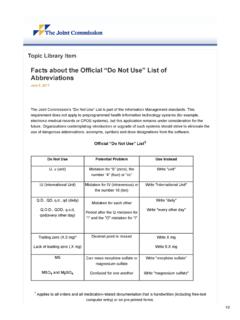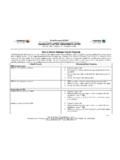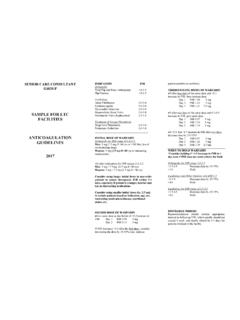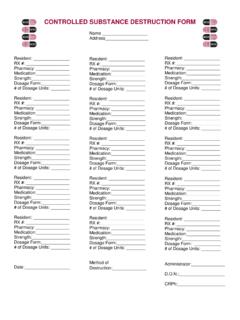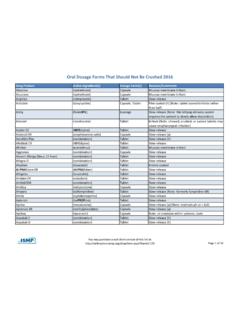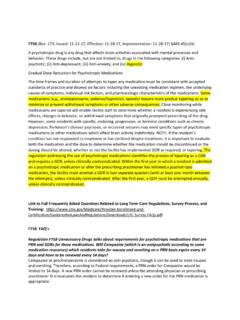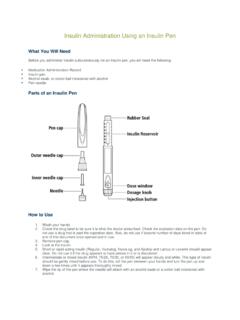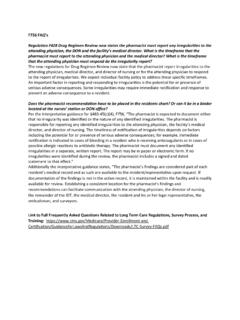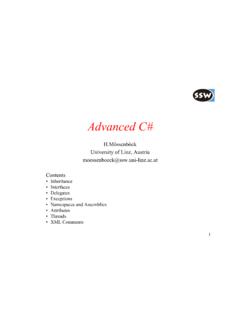Transcription of Recommended Lab Monitoring for Common Medications
1 Detail-Document#: 260704 - CHART Evidence and Advice You Can Recommended Lab Monitoring for Common Medications Full update June 2010 Table is not all-inclusive. Information provided applies to adults. Emphasis is on routine Monitoring , as opposed to symptom-triggered Monitoring ( , checking amylase in event of pancreatitis symptoms). In some situations, signs or symptoms may be better indication of adverse effects than laboratory test results. Recommendations may differ from product labeling. Underlined text denotes laboratory Monitoring Recommended in FDA-approved labeling ( , package insert). Product labeling recommendations are unless otherwise referenced ( , Canadian monograph recommendations included if more conservative).
2 Please note potassium conversion for Canada: mEq/L=mmol/L Abbreviations: ACEI - angiotensin-converting enzyme inhibitor; ARB - angiotensin receptor blocker; BUN - blood urea nitrogen; CCS - Canadian Cardiovascular Society; CrCl - creatinine clearance, GFR - glomerular filtration rate, NSAID - nonsteroidal anti-inflammatory drug; SCr - serum creatinine; T4 - thyroxine; TSH - thyroid stimulating hormone; ULN - upper limit of normal Drug Test Frequency or Indication for Test Rationale Comments Aldosterone antagonists [ , spironolactone, eplerenone (Inspra)] Potassium and renal function ( , serum creatinine) Guidelines: check potassium and renal function baseline, three and seven days after initiation, monthly for three months, then quarterly.
3 Restart Monitoring cycle if ACE inhibitor or ARB added or their dose Eplerenone labeling: check potassium within the first week and one month after dose Eplerenone labeling: check potassium and renal function three to seven days after starting a moderate CYP3A4 inhibitor ( , verapamil, fluconazole). Contraindicated with strong CYP3A4 inhibitors ( , clarithromycin, ketoconazole).2 Antagonism of aldosterone can cause hyperkalemia and worsening renal function1 Guidelines: do not start if serum creatinine > mg/dL (221 umol/L) in men or >2 mg/dL ( umol/L) in women (for spironolactone, >200 umol/L per CCS), or CrCl <30 mL/min., or potassium >5 mEq/L (> mmol/L for spironolactone, per CCS).
4 1,5 Reduce dose or discontinue if serum potassium > Eplerenone labeling: if potassium reaches mEq/L, hold or reduce ,3 Per labeling, do not start if potassium > Per hypertension indication, do not start if SCr >2 mg/dL in men or > mg/dL in women, or CrCl <50 Per Canadian labelling, do not start if CrCl <50 Spironolactone labeling: if potassium >5 mEq/L or SCr > 4 mg/dL, hold or ACEI or ARB Potassium and serum creatinine Check potassium and SCr within 1 to 2 weeks of initiation (within 1 week in elderly) and after dosage increases, then in 3 to 4 weeks if Kidney perfusion in some patients is highly dependent on angiotensin6,8 Discontinue if potassium > Discontinue if serum creatinine increases >30% Page 1 of 13 Detail-Document#: 260704.
5 Pharmacist's Letter7/19/2010 (S(rn03mky2ydch0cvuomq1fa45))/ ,6,8,37 If SCr increased, check again in 2 to 3 weeks, and again in 3 to 4 Then check once or twice yearly, and when patient condition or Medications Low-risk patients (see comments) with serum potassium mEq/L or less could wait 3 to 4 weeks before initial Product labeling generally recommends Monitoring potassium frequently if co-administered with potassium or potassium-sparing diuretics. Routinely monitor renal function and electrolytes when used with aliskiren (Tekturna [ ], Rasilez [Canada]) in patients with within 1st two months of starting drug despite dose Risk factors for adverse renal effects: diabetes; use of NSAID, cyclosporine, or diuretic; renal artery stenosis (risks: elderly, female, smoking, high cholesterol); GFR < 60 mL/min; heart failure; sodium depletion; low albumin; atherosclerosis; dehydration.
6 Hypo- or No evidence ARBs safer for kidneys than Antiarrhythmics Liver function tests Amiodarone: Baseline and every six months30 Hepatotoxic Amiodarone: Liver enzyme elevation may be asymptomatic, may decrease despite continued amiodarone use, or may progress to hepatitis, which may be Amiodarone: If LFTs are >3 times the ULN, or double in a patient with elevated baseline LFTs, consider dosage decrease or Potassium level Flecainide (Tambocor): baseline35 Potassium disturbances may alter drug effects Correct hypo- or hyperkalemia before Antiarrhythmics continued Thyroid function tests Amiodarone: Baseline and every six months30 Can cause hypothyroidism or hyperthyroidism Incidence of hyperthyroidism may be as high as 10%.
7 30 Incidence of hypothyroidism may be as high as 22%.30 Management options include discontinuation; levothyroxine for hypothyroidism; or corticosteroids, antithyroid medication, or surgery for Antiarrhythmic level Flecainide (Tambocor):35,38 routine care (checking trough periodically may be useful) heart failure (goal trough < to 1 mcg/mL Recommended ) liver impairment (early and frequent Monitoring required to guide dose) severe renal impairment (CrCl 35 mL/ or lower) (frequent Monitoring [daily trough, per Canadian labelling] required to guide dose) Narrow therapeutic index drug Flecainide therapeutic range to 1 Increase flecainide dose only when steady-state achieved (about four days; longer in renal and hepatic impairment).
8 35 Mexiletine: therapeutic range to 2 mcg/mL. Peak occurs two to three hours post-dose. Assess peak when toxicity ( , central nervous system adverse effects) is of concern; assess trough when efficacy (arrhythmic control) is of Page 2 of 13 Detail-Document#: 260704: Pharmacist's Letter7/19/2010 (S(rn03mky2ydch0cvuomq1fa45))/ moderate renal impairment (may be helpful during dosage adjustment) use with amiodarone (strongly Recommended to guide dose) use in elderly (daily trough Recommended during dose adjustment, per Canadian labelling) Mexiletine: in the event of potential drug interactions (phenytoin, rifampin, phenobarbital, cimetidine)36 Anticonvulsants Anticonvulsant level Reasons to check level.
9 Loading, or dosage change15-17,19,20 To establish target level in patient with good control and few side effects14,16,18 Suspected toxicity14-16,18 Large variation in levels (phenytoin)16 Starting/stopping interacting drug14,16,18-20,29(See our charts, "Cytochrome P450 Drug Interactions," and "Comparison of Antiepileptic Drugs" [based on product information] for help identifying potential interactions.) Diseases or physiologic changes ( , pregnancy, renal failure)14,15,21-23,26 Poor control14,18 Suspected noncompliance14-16,18 Change in how administered ( , with or without food) (valproate)19,20 Potential malabsorption (phenytoin, carbamazepine)16,18,21 Switching dosage form (phenytoin, valproate)16,19,20 Switching brand (phenytoin)16 Narrow therapeutic index drugs Therapeutic level not well-established for most agents ( , valproatea, newer agents [ , lamotrigine, etc]).
10 17 Unclear benefit of routine blood/serum level Monitoring without clinical Level usually checked in morning immediately prior to dose (trough).17 Checking peak may help assess toxicity for some agents ( , carbamazepine [tablets 4 to 5 hrs post-dose; suspension hrs post- dose; extended-release tablets 3 to 12 hrs post-dose], phenytoin extended-release [4 to 12 hrs post-dose], divalproex [about 4 hrs post-dose].16-18,31 Levels usually checked after at least 4 to 5 half-lives ( , steady-state).17 Valproatea, phenytoin: free (unbound) level more accurate than total level in renal or liver disease, elderly, and ,19 Liver function tests See our chart, "Liver Function Test Scheduling" For agents associated with liver damage Carbamazepine, ethosuximide, felbamate, and valproate require routine liver function Monitoring .)
